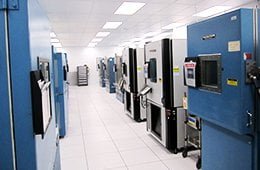RELIABILITY LABORATORY

Technological pressures on the entire electronics industry constantly aim to reduce the size and cost of the transistor while increasing the amount of transistors per chip. However, those deemed critical expectations go against the long-term product reliability. To ensure product reliability over a period of life, the industry has implemented standardized tests. These tests are required to qualify new products and processes and thus control product consistency by simulating the life of products in an accelerated mode.
Mechanical stress
These tests are designed to ensure the functionality of the piece in the event of various impacts or vibrations between the first level assembly (module) and the second (attachment to the card) and when the piece is in use.
- Vibration
- Impact shock
Post stress test
Various checks are performed after stress to ensure the piece did not suffer significant damage that could impact its integrity and functionality.
- Open/short test
- Functional test
- Scanning acoustic microscopy
Environmental stresses
These tests expose the piece to one or more environmental conditions (temperature, humidity, pressure, etc.) for a given time which aims to simulate the conditions of application of the piece or to compare the robustness of different materials to such stress.
- Preconditionning
- Dtc/atc (thermal cycling)
- Thb (temperature, humidity, bias voltage)
- Pct (unbiased autoclave)
- Hast (highly accelerated stress test)
- Moisture resistance
- Hts (high temperature storage)
[equipment category=”laboratory-of-reliability”]

